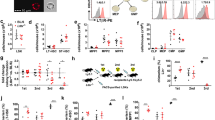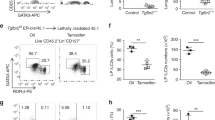Abstract
Toll-like receptors (TLRs) constitute a family of nonpolymorphic receptors that are devoted to pathogen recognition. In this work, we have explored the impact of TLR ligands (TLR-L) on human hematopoietic stem cells (HSCs) and hematopoietic progenitor cells (HPCs). We show that HSCs and HPCs have a comparable pattern of expression of TLR transcripts characterized by the predominance of TLR1, -2, -3, -4 and -6. In long-term cultures of HSCs, HPCs and stromal cells, most TLR-L profoundly inhibited B-cell development while preserving or enhancing the production of myeloid cells. In short-term cultures, the TLR1/2 ligand PAM3CSK4 induced a large proportion of HPCs to express markers of the myelomonocytic lineage. PAM3CSK4 induced only marginal expression of myeloid lineage markers on HSCs but promoted their myeloid commitment as revealed by their acquisition of the phenotype of multi- and bipotential myeloid progenitors and by upregulation of the transcription factors PU.1, C/EBPα and GATA-1. Our results suggest that TLR agonists can bias the lineage commitment of human HSCs and shift the differentiation of lineage-committed progenitors to favor myelopoiesis at the expense of lymphoid B-cell development.
This is a preview of subscription content, access via your institution
Access options
Subscribe to this journal
Receive 12 print issues and online access
$259.00 per year
only $21.58 per issue
Buy this article
- Purchase on Springer Link
- Instant access to full article PDF
Prices may be subject to local taxes which are calculated during checkout







Similar content being viewed by others
References
Laiosa CV, Stadtfeld M, Graf T . Determinants of lymphoid-myeloid lineage diversification. Annu Rev Immunol 2006; 24: 705–738.
Orkin SH . Diversification of haematopoietic stem cells to specific lineages. Nat Rev Genet 2000; 1: 57–64.
Singh H, Medina KL, Pongubala JM . Contingent gene regulatory networks and B cell fate specification. Proc Natl Acad Sci USA 2005; 102: 4949–4953.
Marsh JC, Boggs DR, Cartwright GE, Wintrobe MM . Neutrophil kinetics in acute infection. J Clin Invest 1967; 46: 1943–1953.
Terashima T, Wiggs B, English D, Hogg JC, van Eeden SF . Polymorphonuclear leukocyte transit times in bone marrow during streptococcal pneumonia. Am J Physiol 1996; 271: L587–L592.
Mirandola P, Secchiero P, Pierpaoli S, Visani G, Zamai L, Vitale M et al. Infection of CD34(+) hematopoietic progenitor cells by human herpesvirus 7 (HHV-7). Blood 2000; 96: 126–131.
Dorshkind K . IL-1 inhibits B cell differentiation in long term bone marrow cultures. J Immunol 1988; 141: 531–538.
Nagaoka H, Gonzalez-Aseguinolaza G, Tsuji M, Nussenzweig MC . Immunization and infection change the number of recombination activating gene (RAG)-expressing B cells in the periphery by altering immature lymphocyte production. J Exp Med 2000; 191: 2113–2120.
Ueda Y, Yang K, Foster SJ, Kondo M, Kelsoe G . Inflammation controls B lymphopoiesis by regulating chemokine CXCL12 expression. J Exp Med 2004; 199: 47–58.
Ueda Y, Kondo M, Kelsoe G . Inflammation and the reciprocal production of granulocytes and lymphocytes in bone marrow. J Exp Med 2005; 201: 1771–1780.
Nagai Y, Garrett KP, Ohta S, Bahrun U, Kouro T, Akira S et al. Toll-like receptors on hematopoietic progenitor cells stimulate innate immune system replenishment. Immunity 2006; 24: 801–812.
Sioud M, Floisand Y, Forfang L, Lund-Johansen F . Signaling through toll-like receptor 7/8 induces the differentiation of human bone marrow CD34+ progenitor cells along the myeloid lineage. J Mol Biol 2006; 364: 945–954.
Sioud M, Floisand Y . TLR agonists induce the differentiation of human bone marrow CD34+ progenitors into CD11c+ CD80/86+ DC capable of inducing a Th1-type response. Eur J Immunol 2007; 37: 2834–2846.
Hao QL, Zhu J, Price MA, Payne KJ, Barsky LW, Crooks GM . Identification of a novel, human multilymphoid progenitor in cord blood. Blood 2001; 97: 3683–3690.
Edvardsson L, Dykes J, Olofsson T . Isolation and characterization of human myeloid progenitor populations--TpoR as discriminator between common myeloid and megakaryocyte/erythroid progenitors. Exp Hematol 2006; 34: 599–609.
Manz MG, Miyamoto T, Akashi K, Weissman IL . Prospective isolation of human clonogenic common myeloid progenitors. Proc Natl Acad Sci USA 2002; 99: 11872–11877.
Rawlings DJ, Quan SG, Kato RM, Witte ON . Long-term culture system for selective growth of human B-cell progenitors. Proc Natl Acad Sci USA 1995; 92: 1570–1574.
Fluckiger AC, Sanz E, Garcia-Lloret M, Su T, Hao QL, Kato R et al. In vitro reconstitution of human B-cell ontogeny: from CD34(+) multipotent progenitors to Ig-secreting cells. Blood 1998; 92: 4509–4520.
Genestier L, Taillardet M, Mondiere P, Gheit H, Bella C, Defrance T . TLR agonists selectively promote terminal plasma cell differentiation of B cell subsets specialized in thymus-independent responses. J Immunol 2007; 178: 7779–7786.
Traggiai E, Chicha L, Mazzucchelli L, Bronz L, Piffaretti JC, Lanzavecchia A et al. Development of a human adaptive immune system in cord blood cell-transplanted mice. Science 2004; 304: 104–107.
Gimeno R, Weijer K, Voordouw A, Uittenbogaart CH, Legrand N, Alves NL et al. Monitoring the effect of gene silencing by RNA interference in human CD34+ cells injected into newborn RAG2-/- gammac-/- mice: functional inactivation of p53 in developing T cells. Blood 2004; 104: 3886–3893.
Guerriero A, Langmuir PB, Spain LM, Scott EW . PU.1 is required for myeloid-derived but not lymphoid-derived dendritic cells. Blood 2000; 95: 879–885.
DeKoter RP, Singh H . Regulation of B lymphocyte and macrophage development by graded expression of PU.1. Science 2000; 288: 1439–1441.
Nutt SL, Heavey B, Rolink AG, Busslinger M . Commitment to the B-lymphoid lineage depends on the transcription factor Pax5. Nature 1999; 401: 556–562.
Pevny L, Simon MC, Robertson E, Klein WH, Tsai SF, D'Agati V et al. Erythroid differentiation in chimaeric mice blocked by a targeted mutation in the gene for transcription factor GATA-1. Nature 1991; 349: 257–260.
Visvader JE, Elefanty AG, Strasser A, Adams JM . GATA-1 but not SCL induces megakaryocytic differentiation in an early myeloid line. EMBO J 1992; 11: 4557–4564.
Nerlov C, McNagny KM, Doderlein G, Kowenz-Leutz E, Graf T . Distinct C/EBP functions are required for eosinophil lineage commitment and maturation. Genes Dev 1998; 12: 2413–2423.
Zhang DE, Zhang P, Wang ND, Hetherington CJ, Darlington GJ, Tenen DG . Absence of granulocyte colony-stimulating factor signaling and neutrophil development in CCAAT enhancer binding protein alpha-deficient mice. Proc Natl Acad Sci USA 1997; 94: 569–574.
Suh HC, Gooya J, Renn K, Friedman AD, Johnson PF, Keller JR . C/EBPalpha determines hematopoietic cell fate in multipotential progenitor cells by inhibiting erythroid differentiation and inducing myeloid differentiation. Blood 2006; 107: 4308–4316.
Xie H, Ye M, Feng R, Graf T . Stepwise reprogramming of B cells into macrophages. Cell 2004; 117: 663–676.
Laiosa CV, Stadtfeld M, Xie H, de Andres-Aguayo L, Graf T . Reprogramming of committed T cell progenitors to macrophages and dendritic cells by C/EBP alpha and PU.1 transcription factors. Immunity 2006; 25: 731–744.
Terstappen LW, Huang S, Safford M, Lansdorp PM, Loken MR . Sequential generations of hematopoietic colonies derived from single nonlineage-committed CD34+CD38- progenitor cells. Blood 1991; 77: 1218–1227.
Iwasaki H, Somoza C, Shigematsu H, Duprez EA, Iwasaki-Arai J, Mizuno S et al. Distinctive and indispensable roles of PU.1 in maintenance of hematopoietic stem cells and their differentiation. Blood 2005; 106: 1590–1600.
Zhu J, Emerson SG . Hematopoietic cytokines, transcription factors and lineage commitment. Oncogene 2002; 21: 3295–3313.
Oh IH, Lau A, Eaves CJ . During ontogeny primitive (CD34(+)CD38(−)) hematopoietic cells show altered expression of a subset of genes associated with early cytokine and differentiation responses of their adult counterparts. Blood 2000; 96: 4160–4168.
Acknowledgements
This work was supported by grants from ARC, and K De Luca was supported by the French Society for Hematology. We thank the physicians and nurses of the Department of Obstetrics of the Clinique du Tonkin (Lyon, Villleurbanne) for their invaluable help in collecting cord blood samples. We are particularly indebted to Mrs Sylvaine Coponat (Clinique du Tonkin) for her motivation and dedication to maintaining the link between clinics and research.
Author information
Authors and Affiliations
Corresponding author
Additional information
Supplementary Information accompanies the paper on the Leukemia website (http://www.nature.com/leu)
Supplementary information
Rights and permissions
About this article
Cite this article
De Luca, K., Frances-Duvert, V., Asensio, MJ. et al. The TLR1/2 agonist PAM3CSK4 instructs commitment of human hematopoietic stem cells to a myeloid cell fate. Leukemia 23, 2063–2074 (2009). https://doi.org/10.1038/leu.2009.155
Received:
Revised:
Accepted:
Published:
Issue Date:
DOI: https://doi.org/10.1038/leu.2009.155
Keywords
This article is cited by
-
Systemic administration of STING agonist promotes myeloid cells maturation and antitumor immunity through regulating hematopoietic stem and progenitor cell fate
Cancer Immunology, Immunotherapy (2023)
-
Hematopoietic responses to SARS-CoV-2 infection
Cellular and Molecular Life Sciences (2022)
-
Prostaglandin E2 Regulates Bipotent Monocyte-Dendritic Progenitor Cell Lineage-Commitment
Stem Cell Reviews and Reports (2021)
-
Toll-like receptor 2 expression on c-kit+ cells tracks the emergence of embryonic definitive hematopoietic progenitors
Nature Communications (2019)
-
Imiquimod inhibits growth and induces differentiation of myeloid leukemia cell lines
Cancer Cell International (2018)



